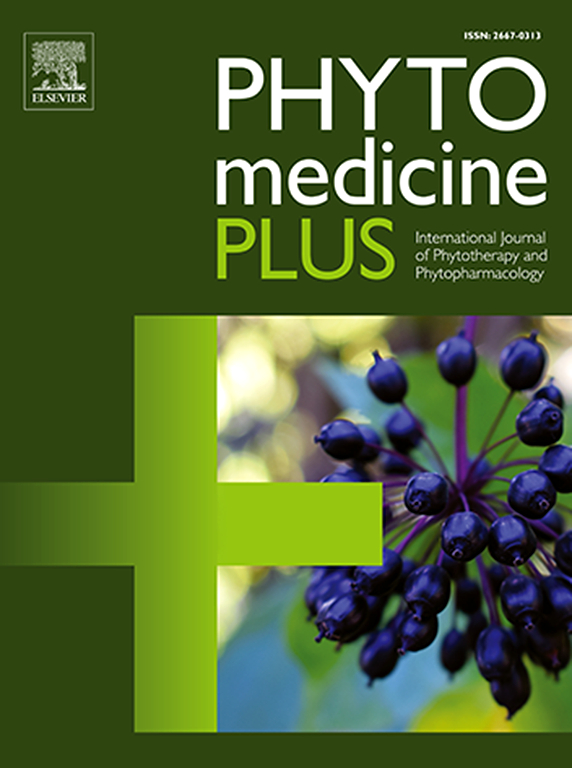小茴香和大茴香提取物对MCF-7细胞系的抗癌作用:体外评价
Q3 Pharmacology, Toxicology and Pharmaceutics
引用次数: 0
摘要
摘要本研究旨在鉴定两种植物水醇提取物对人MCF-7细胞的抗氧化活性,评价其体外抗氧化和抗癌活性,并探讨其可能的抗癌作用机制。方法采用气相色谱-质谱联用法对小茴香果肉、果汁、种子的水醇提取物进行化学成分鉴定,并分别采用DPPH法和MTT法对其体外抗氧化细胞毒性进行研究。进一步对有希望的提取物进行流式细胞分析。通过细胞凋亡和qRT-PCR研究其抗癌机制。结果用GraphPad Prism 8软件进行分析,以均数±SEM计算,p值<;0.05认为有统计学意义。结果用气相色谱-质谱联用分析方法,鉴定出芫荽和芫荽水醇提取物(果肉、种子、果汁)中含有113种化合物;表明含有大量的正十六烷酸、三烷酸和十二烷酸。在提取物中,小茴香籽提取物具有较强的抗氧化活性,IC50值为45 μg/ml。果浆、果汁提取物对MCF-7细胞具有明显的细胞毒活性,IC50值为80.75 μg/ml。进一步的机理研究表明,sc &;western blotting结果显示,sj种子提取物在S期阻滞细胞周期,并通过增加p53诱导细胞凋亡。结论:小茴香和大茴香的水醇提取物具有一定的抗氧化活性。鱼尾草具有潜在的抗癌特性。进一步的研究可以解释其作用机制并探索其治疗应用。本文章由计算机程序翻译,如有差异,请以英文原文为准。

Anti-cancer potential of Syzygium cumini and Syzygium Jambolanum extracts against MCF-7 cell line: An in vitro evaluation
Background
This research has been carried out to evaluate the anticancer activity of hydroalcoholic extracts of Syzygium cumini and Syzygium jambolanum against human MCF-7 cells .
Purpose
This study aims to identify the bioactive compounds present in the extracts, assess their in vitro antioxidant and anticancer potential, along with the possible mechanism of action for its anticancer property.
Methods
Hydroalcoholic extracts of S. cumini and S. jambolanum fruit pulp, Juice, Seed was subjected to GC–MS to identify its chemical compositions followed by invitro antioxidant cytotoxicity study by DPPH, MTT assay respectively. Further the promising extract was tested for Flow cytometric analysis. Apoptosis and qRT-PCR studies to investigate the mechanism of anticancer. Results were analyzed with GraphPad Prism 8 software and calculated as mean±SEM, p-value of <0.05 was considered to be statistically significant.
Results
GC–MS analysis of hydroalcoholic extracts of Syzygium cumini and Syzygium Jambolanum (Fruit Pulp, Seed, Juice) found 113 compounds & indicated significant amounts of n-hexadecanoic, tridecanoic, and dodecanoic acids. Among the extract S. cumini seed extract showed considerable antioxidant activity and the IC50 value 45 μg/ml though both S.C & S.J H.C extracts of Fruit pulp, Juice had and marked Cytotoxicity activity against MCF-7 cells with IC50 value 80.75 μg/ml. Further mechanistic studies revealed that both the S.C & S.J seed extracts showed cell cycle arrest in S phase and caused induction of apoptosis, via the increased, of p53 by western blotting studies.
Conclusion
The findings suggest that among hydroalcoholic extracts of S. cumini and S. jambolanum. S. cumini possess potential anticancer properties. Further studies can be warranted to explain the mechanisms of action and explore their therapeutic applications.
求助全文
通过发布文献求助,成功后即可免费获取论文全文。
去求助
来源期刊

Phytomedicine Plus
Medicine-Complementary and Alternative Medicine
CiteScore
3.70
自引率
0.00%
发文量
178
审稿时长
81 days
期刊介绍:
 求助内容:
求助内容: 应助结果提醒方式:
应助结果提醒方式:


